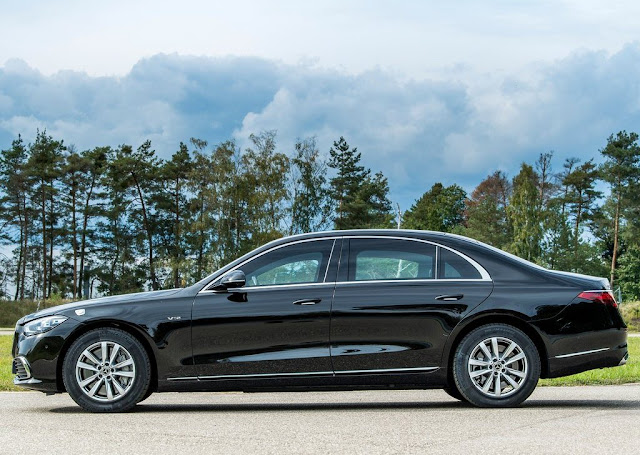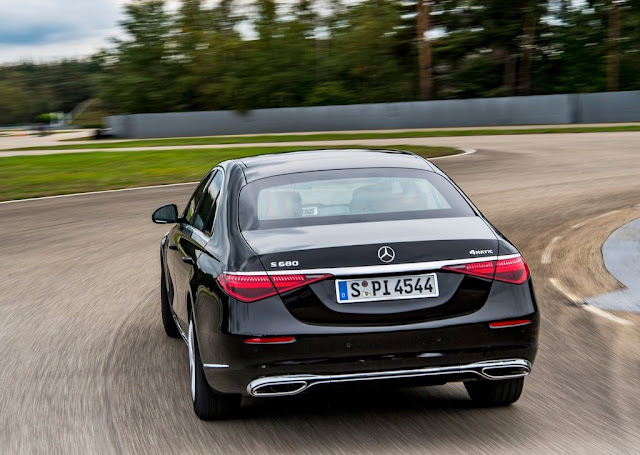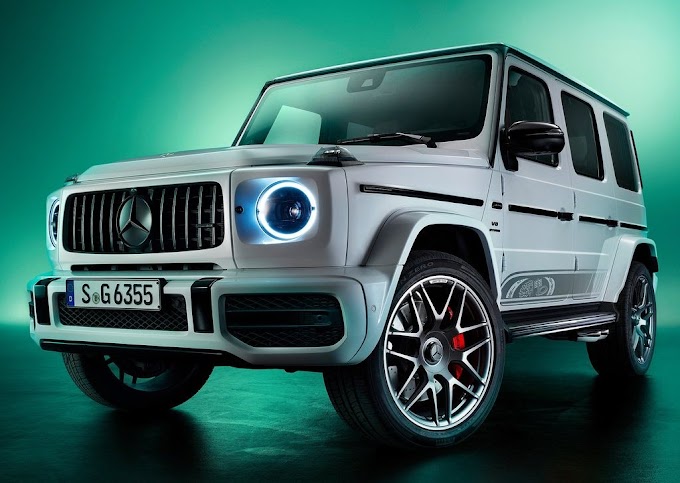 |
| 2022 Mercedes-Benz S680 Guard 4Matic Front View |
 |
| 2022 Mercedes-Benz S680 Guard 4Matic Side View |
 |
| 2022 Mercedes-Benz S680 Guard 4Matic Dashboard View |
 |
| 2022 Mercedes-Benz S680 Guard 4Matic Seat View |
 |
| 2022 Mercedes-Benz S680 Guard 4Matic Rear View |
The new Mercedes-Benz S680 GUARD 4MATIC is certified according to directives of the VPAM (Association of test centres for attack-resistant materials and structures). Members of the VPAM are company-independent (neutral) test centres and institutions.
The testing was carried out by the Beschussamt Ulm, the only testing and certification body for weapons, ammunition and safety technology in the German state of Baden-Württemberg and one of the most state-of-the-art institutes of its kind. The new S-Class GUARD meets the requirements of the highest civilian protection class VR10 according to the standard VPAM BRV version three (Bullet Resistant Vehicles). In this test, the body and windows must withstand fire from an assault rifle using armour-piercing ammunition. The S680 GUARD 4MATIC also meets the requirements of Germany's Federal Criminal Police Office (BKA).
Protection against blast attacks is documented by compliance with the latest version of the VPAM ERV(Explosive Resistant Vehicles) standard, the test criteria for which are not freely available. The S680 GUARD 4MATIC was not only the very first vehicle to complete the current tests, it also achieved the top scores in all three tests (roof, floor and side) with three out of three stars. Test result: "no injuries" to dummies and indicators according to assessment scheme VPAM ERV.
For the first time, the VPAM ERV certification in this case included tests with so-called biofidelic dummies. Consideration was given to the injuries to the dummies on all seats, which differ in design (depending on the test case). The Primus model used was developed by CTS Company together with the Technical University of Berlin (TU Berlin) and the Dresden University of Applied Sciences (HTW Dresden), incorporating findings from the Berlin Charité teaching hospital.
Primus is particularly well suited for this special use: bone density and structure are modelled on the human skeleton in every detail. Epoxy resin aluminium powder is used as a bone substitute, and webbing made of propylene is used as ligaments and tendons. The tissue and internal organs of this biofidelic dummy are made of silicone and acrylic. Thanks to the human-like structure, injuries are easily recognisable from the outside. The evaluation was based on the most severely affected dummy or seat.
Other technical refinements: new door actuators and hydraulically operated window lifters
The highest level of protection combined with the best possible comfort for passengers and staff, that is the GUARD philosophy. This can be illustrated with two examples. The S680 GUARD 4MATIC, for example, features newly developed door actuators. Although the doors are very heavy due to their armouring, this electro-mechanical system means that only low operating forces are required for opening and closing. This applies not only on level ground, but also when the vehicle is on a slope. The stepless door arrest also proves its worth in this situation. The door's sensor technology detects when and how it is to be moved or stopped. Algorithms from human-supporting robotics (cobots) are used. The system facilitates the work of the bodyguards in particular, and at the same time they can keep one hand free.
There is also a lot of intelligence in the hydraulically (instead of electrically) operated window lifters. Even if the on-board power supply fails, emergency operation is possible, i.e. closing in the event of an attempted attack. In each door there is a corresponding unit consisting of a compressor and valve block together with a pressure accumulator.
Other special equipment designed specifically for the S680 GUARD 4MATIC includes a fire extinguishing system with automatic triggering function and an emergency fresh air system that protects occupants from penetrating smoke or irritant gases and supplies them with fresh air. Other special GUARD options include an extensive range of equipment for authorities, such as a siren, flashing lights and radios, as well as a panic alarm system.
The Michelin PAX run-flat tyres are a standard feature. Even with defective tyres, it is possible to move out of the danger zone up to a distance of 30 kilometres.
Powertrain: first GUARD saloon with 4MATIC
The V12 biturbo power unit has been extensively revised for its use in the new S-Class generation. The exhaust gas turbochargers, exhaust manifold and air ducting were all adapted. Also new is a closed-loop petrol particulate filter. The V12 has an output of 450 kW/612 hp and a displacement of 5980 cc. The maximum torque is 830 Nm from 2000 rpm. The most important features of the engine include an all-aluminium crankcase, a one-piece chain drive, a forged crankshaft made of high-quality quenched and tempered steel, forged pistons and a multi-spark ignition system with twelve twin-power ignition coils.
Features of the all-wheel-drive system, combined here for the first time with the twelve-cylinder engine, include a low system weight, optimal traction and driving safety, and the highest levels of ride comfort and driving dynamics. The standard torque distribution for this model is 31 percent to the front axle and 69 percent to the rear axle. Among other things, the all-wheel drive was adapted to the higher vehicle weight of the GUARD version with stronger side shafts.
Experience: Mercedes-Benz has been building special-protection vehicles for over 90 years
It started way back with the 1928 Nürburg 460 model, when Daimler-Benz became the first company to begin factory-fitting saloons with special protective features to shield the occupants from gunshots and explosives. Mercedes-Benz also developed special-protection variants of the subsequent luxury-class and state vehicles such as the "Grand Mercedes" 770 and the 500 model. The Japanese Emperor Hirohito personally chose an armoured "Grand Mercedes" as a befitting vehicle for his own use. This vehicle was delivered in 1935.
Many politicians and heads of state followed the emperor's example and entrusted their safety and security to Mercedes-Benz special-protection vehicles. From 1965 onwards, the company offered numerous models with special protection. In addition to the legendary Mercedes-Benz 600 as a Saloon and Pullman Saloon, these included V8 models of the S-Class in the 1970s and 1980s, such as the 280 SEL 3.5, the 350 SE/SEL and 450 SE/SEL as well as the 380 SE/SEL to 560 SEL.
In 2016, the company presented the Mercedes-Maybach S 600 Guard, the first model to offer the highest level of protection for civilian vehicles with resistance class VR10.
Interesting facts & figures
The Primus biofidelic dummy from CTS has 42 bones - this number corresponds to about one fifth of the human skeleton. In addition, there are twelve soft-tissue components and internal organs. All in all, the luggage compartment holds about 390 litres, as the (optional) refrigerator is located in the centre armrest in the rear. Behind it is an armoured firewall.
The S-Class GUARD can still drive a distance of up to 30 kilometres after a puncture thanks to Michelin PAX run-flat tyres. The S680 GUARD 4MATIC is available in four- and five-seater versions. The basic price is €457,100 plus value added tax.
Mercedes-Benz has been building special-protection vehicles for 93 years. The first model was the Nürburg 460. For weight reasons, the top speed is electronically limited to 190 km/h.
After the Mercedes-Benz S-Class with short and long wheelbase and the Mercedes-Maybach S-Class, the GUARD is already the fourth body variant of the new generation.













0 Comments